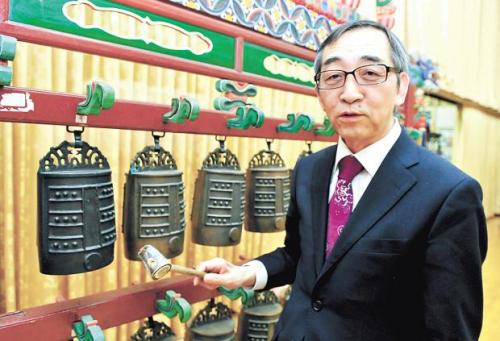National Gugak Center’s new director seeks blend of Korean music with other arts
It’s been almost two months since the National Gugak Center’s new director and scholar Lee Tong-bok took office. The position might have been a challenging one for Lee, a professor at Kyungpook National University in Daegu since 1984. Yet he says it’s as if he has returned home.
“I was a performing member of the National Gugak Center from 1979 to 1982,” Lee told The Korea Herald at the institution on Wednesday. “So it’s like being home again after spending 30 years somewhere else.”
Many things are on his agenda, but Lee, wearing a purple colored hanbok-style tie, says gugak collaborations with other forms of art and culture are at the top of his list.
Just last month the National Gugak Center signed an MOU with the World Taekwondo Headquarters to promote Korean culture by bringing together gugak and taekwondo. Under the agreement, the gugak center will generate traditional Korean music scores for the national martial art’s “poomsae,” the formal sequences of taekwondo movements and posture.
In May, the center also is planning to perform Korean traditional court music in New York during a hanbok fashion show in celebration of the 130th anniversary of Korea-U.S. relations.
“I’ve always been interested in ways to complement gugak with other forms of art or activities,” Lee said. “It could be Korean cuisine, the traditional houses, yoga and even prenatal education.”
It’s been almost two months since the National Gugak Center’s new director and scholar Lee Tong-bok took office. The position might have been a challenging one for Lee, a professor at Kyungpook National University in Daegu since 1984. Yet he says it’s as if he has returned home.
“I was a performing member of the National Gugak Center from 1979 to 1982,” Lee told The Korea Herald at the institution on Wednesday. “So it’s like being home again after spending 30 years somewhere else.”
Many things are on his agenda, but Lee, wearing a purple colored hanbok-style tie, says gugak collaborations with other forms of art and culture are at the top of his list.
Just last month the National Gugak Center signed an MOU with the World Taekwondo Headquarters to promote Korean culture by bringing together gugak and taekwondo. Under the agreement, the gugak center will generate traditional Korean music scores for the national martial art’s “poomsae,” the formal sequences of taekwondo movements and posture.
In May, the center also is planning to perform Korean traditional court music in New York during a hanbok fashion show in celebration of the 130th anniversary of Korea-U.S. relations.
“I’ve always been interested in ways to complement gugak with other forms of art or activities,” Lee said. “It could be Korean cuisine, the traditional houses, yoga and even prenatal education.”

Lee in fact participated in producing a record which comprises a number of gugak pieces that are ideal for prenatal education in 2003.
“Not all gugak music is good for prenatal education, of course,” he said.
“The piece has to have a narrow range of notes, preferably a performed solo, and has to be slow music. Unlike Western music, gugak comprises the philosophy that connects to the universe and nature. It’s made of our sound, so it’s good for our yet-to-be born.”
Lee expressed particular concern for the growing violence among teenagers, as well as the increasing number of teen suicides.
“I think it has a lot to do with our education,” he said. “Gugak is the most basic sentiment of the Korean people. Its connection to nature heals us and inspires us. But we don’t teach our kids enough about it. Most of the sounds we constantly hear these days are far faster than the beat of our pulse. And this does not allow us to be emotionally stable and healthy.”
Coming up with proper gugak textbooks, providing smaller-sized gugak instruments for children, as well as generating interactive online learning activities for gugak students are on Lee’s mind.
“For children, learning music should not be easy and fun,” he said. “But gugak instruments like gayageum or geomungo are simply too big for them and easily come off as something intimidating. It should be like how children learn violin. Gugak instruments should be made available in many different sizes so kids can learn more easily.”
The National Gugak Center had a European tour last year, showcasing different pieces of Korea’s traditional music in Germany and France. This year, the institute is planning another German tour in July ― participating in TFF Rudolstadt ― Germany’s biggest folk, roots and world music festival.
“I think what sells the most overseas is the most traditional,” he said. “But you can’t only eat bulgogi every single day, even if you love the dish very much. So we need to create variations, while celebrating the most traditional form of gugak at the same time.”
By Claire Lee
(dyc@heraldcorp.com)












![[Today’s K-pop] BTS pop-up event to come to Seoul](http://res.heraldm.com/phpwas/restmb_idxmake.php?idx=644&simg=/content/image/2024/04/17/20240417050734_0.jpg&u=)




![[KH Explains] Hyundai's full hybrid edge to pay off amid slow transition to pure EVs](http://res.heraldm.com/phpwas/restmb_idxmake.php?idx=652&simg=/content/image/2024/04/18/20240418050645_0.jpg&u=20240418181020)

![[Today’s K-pop] Zico drops snippet of collaboration with Jennie](http://res.heraldm.com/phpwas/restmb_idxmake.php?idx=642&simg=/content/image/2024/04/18/20240418050702_0.jpg&u=)